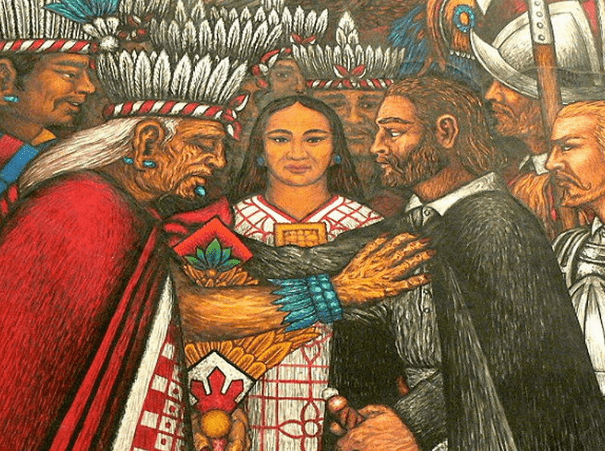Winner of the Fall 2016 StMU History Media Award for
Best Article in the Category of “People”
Best Article in the Category of “World History”
Largely due to the importation of disease and use of superior weapons, the Spaniards were able to conquer the Aztec capital of Tenochtitlan, kill the empire’s last emperor, Cuauhtémoc, and bring the Aztec empire to an end. Few know of La Malinche, the indigenous interpreter of Hernán Cortés, whose linguistic abilities were used to facilitate important conversations between the Spaniards and the indigenous leaders. Without the help of La Malinche, perhaps the Aztec empire would have survived.
Born between 1502 and 1505, La Malinche was named Malinalli Tenepal, the first part of her name being a Nahuatl term for the twelfth day of the month in correspondence to the Aztec calendar, and the second part of her name meaning “lively.” She was born of nobility in Paynala within the region of Veracruz. Her troubles started at a young age after the death of her father. La Malinche was ousted from her home to ensure her new half-brother received the inheritance of the family instead of her, since she was the eldest child. She was given to “some Indians of Xicalango.”1 Then the Indians gave her to a nobleman in Tobasco, a region in the Yucatan. When Cortés arrived to Tobasco, he was offered twenty slaves, one of them being La Malinche. Having lived in Veracruz, a Nahuatl-speaking region, and then being sold into a Maya-speaking region, La Malinche knew both languages and she was soon recognized for the linguistic talents that could benefit Cortés in his conquests.2

The few glimpses of La Malinche and how her presence as an interpreter accelerated the fall of the Aztec empire can be found in the writings of the Spanish explorers, specifically from Hernán Cortés, her “lord and master.”3 From the second letter Hernán Cortés wrote to Emperor Charles V, dated October 30, 1530, Cortés speaks of La Malinche as “a female interpreter that I had, who was a native of this country, and whom I obtained at Putunchún on the Rio Grande.”4 This confirms the vague aspects of her life that we already know. But most importantly, in this context, this letter goes on to tell of a scenario in which La Malinche saved the Spaniards from an ambush by the Cholulans. La Malinche was told by the wife of a native leader that they planned to attack the Spaniards and if La Malinche came with them, she would be protected. La Malinche delivered this message to Cortés, which ultimately led to the massacre of Cholula and provided a direct path to march towards Tenochitlan, the capital of the Aztec empire.5 This leads to the question of whether or not La Malinche was a traitor or a survivor. Did she explicitly want the Aztec empire to fall or did she just want to save herself from the carnage?
With no traces of primary sources from La Malinche herself, her story has been retold by various scholars without much consistency, nothing ever being certain. Up until the twentieth century, La Malinche was viewed as a traitor to her country Mexico. In 1861, on the celebration day of Mexico’s Independence, Ignacio “El Nigromante” Ramírez, a Mexican journalist, addressed the Mexican people by saying, “One of the mysteries of fate is that every Mexican owes his downfall and disgrace to a woman, and to another woman his salvation and glory; the myth of Eve and Mary is reproduced everywhere; we indignantly remember Cortés’s mistress and will never forget, in our gratitude to Doña María Josefa Ortiz.”6 La Malinche is seen as playing a key role in the subjugation of the Mexican peoples to Spain, while Doña María Josefa Ortiz did the contrary and liberated the country. However, many Chicana writers and modern scholars are trying to rewrite the tale of La Malinche to understand the complexities of her choices and to vindicate her. For example, Gloria Anzaldua promotes the idea that La Malinche had a “new consciousness,” that she voluntarily served as the interpreter of Cortés not only to save herself, but also because she knew that a new mestiza culture was going to be born (especially considering she had a son with Cortés in 1524).7 She made a conscious effort to exchange language and cultural aspects from each side in order to facilitate the emergence of the new mestiza society; however, with that came brutal consequences in the shape of warfare and mass death in the New World.
Whether or not La Malinche’s role as Cortés’s interpreter was traitorous, simply an effort to survive, or some other complex reason involving love for Cortés, hate for the Aztec empire for the cruelty she faced after being ousted from her home, or promotion of the new mestiza culture, no one will ever know the true story of the Indian, slave woman who traveled alongside Cortés towards the culmination of the Aztec empire.
- Bernal Castillo del Díaz, The Discovery and Conquest of Mexico, 1517-1521 rev. American ed., trans. A.P. Maudsley (New York: The Noonday Press, 1965), chap. 22-23. ↵
- Pilar Godayol, “Malintzin/ La Malinche/ Doña Marina: re-reading the myth of the treacherous translator,” Journal of Iberian and Latin American Studies 18, no. 1 (April 2012): 61-68. ↵
- Castillo del Bernal, chap 23. ↵
- Hernan Cortes to Emperor Charles V, October 30, 1520, in Letters of Despatches of Hernando Cortes, to the Emperor Charles V., trans. (New York: Wiley and Putnam, 1843), letter II. ↵
- Hernan Cortes to Emperor Charles V, October 30, 1520, in Letters of Despatches of Hernando Cortes, to the Emperor Charles V, letter II. ↵
- Rosario Pérez-Lagunes, “The Myth of La Malinche: From the Chronicles to Modern Mexican Theater” (PhD dis., Virginia Polytechnic Institute and State University, 2001), 24. Although she was of Spanish descent, Doña María Josefa Ortiz was born in Valladolid, Mexico in 1768 and identified herself as Mexican. She and her husband were both a part of the rebellion that ultimately led to Mexico’s independence from Spain in 1824. ↵
- Godayol, 68-70. ↵



230 comments
Danielle Slaughter
I like how this article presents La Malinche in a human light, neither vilifying nor vindicating her. It is a complex chapter in the narrative of the Aztec empire’s downfall and the Spanish empire’s conquest, one that needs to be reevaluated and told as truthfully as possible, which you as the author have done so. Definitely a prize-winning article! Congratulations on your awards, Mariana.
Shine Trabucco
I appreciate that you pointed out how this culture sees women as having such an influence, good and bad, on its culture and livelihood. Its great to look back and idealize what possibly could have motivated her. I did not know that she had a child with Cortez, that changes everything when looking at it through the eyes of a mother. She herself was thrown out and sold so its very easy to see that she could have been thinking “I will protect my child at all costs!!” I liked all the different perspectives laid out.
John Cadena
Immediately became excited with anticipation to read this. As I began reading, I think I became most attracted to what I interpreted as the plot points within the story. This may have actually been the rising action. In any case, it was the build-up this I thought was very well done. Familiar with this story, I found it thrilling to see so many of the little points about her story included. Growing up, the association or affiliation with being known as a Malinche is a negative one. For those who don’t know why, this is a great beginning.
Edgar Velazquez Reynald
I’ve always been fascinated with La Malinche and love to read anything about her. It’s unfortunate, she being a talented linguist, we have no primary sources to understand what she thought. I absolutely agree with reinterpreting her actions. It is very unfair that as a nation, Mexico blames the downfall of the Aztec empire all on one woman.
Scott Sleeter
Great story about an important figure that most people don’t really hear about. This article does a great job showing the main problem of Central American history, and that is the lack of primary sources from the natives. The Spanish did an incredible job of destroying all the codex and other written materials that the natives produced. Most of the accounts we have of Aztec life are written from the Spanish point of view.
Geremy Landin
I absolutely love the articles and readings I take on that regard cultures and activities of the Spaniards and Aztecs. Being part Spaniard and part Mexican has influenced this greatly and I want to take time in adulthood to continue to learn about my deep roots and it starts with stories like these. I’ve talked to Dr. Van Hoy about La Malinche and I have to agree with Dr. Wieck’s comment. I enjoy how you show that La Malinche is looked at in different ways. We all are. The importance of fluency in multiple languages can have a great impact on lives and I know that personally, Spanish has had that effect on my life.
Danielle A. Garza
The introduction is a short overview that gives the reader a head start into what is being said and a foreshadow effect of what is to come. An interesting point I took out of this article is the origins of La Malinche. I did not know she was of nobility or why she came to be a slave of Cortes. The conclusion allowed the author to place their last thoughts. The article was clean and very streamlined.
Lindsey Wieck
Mariana,
I like how you consider that La Malinche means different things to different people, and ultimately leave the mystery of her life and the things she did as a mystery. This is now a required reading in my graduate Advanced Public History methods course.
Mario Sosa
Excellent article. I have often heard about whether La Malinche really wanted the Aztecs gone or if she was simply saving herself, but the idea that she helped Cortez in order to promote the emerging mestiza culture is new to me. Unfortunately because of a lack of primary sources from La Malinche herself and the inconsistency of second-hand accounts, her motives could always just remain a speculation.
Hali Garcia
This article really makes me think. Yes she could be viewed as a traitor because she could have lead to the fall of the Aztec empire because she helped Cortes through her translations and she could have just wanted to help the Spaniards survive. She could have also helped Cortes because she was angry about how she was treated when she was kicked out.